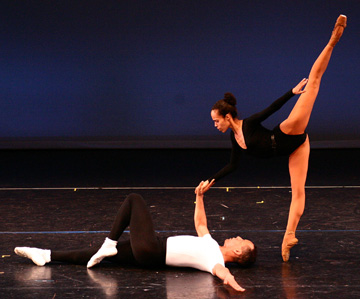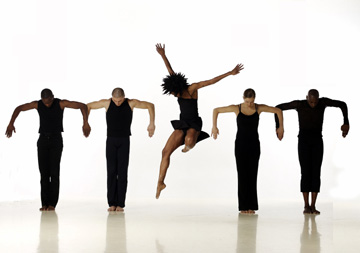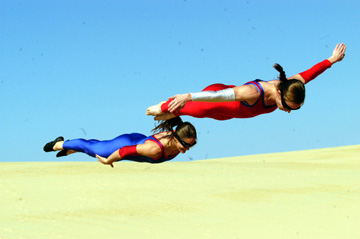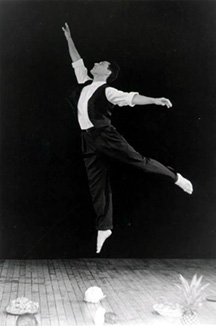Falling in Love
Fall for Dance Festival
City Center
New York, New York
September 28-29, 2004
By
Nancy Dalva
copyright
© 2004 by Nancy
Dalva
published October 4, 2004
Tuesday,
September 28, 2004:
"Agon"/Dance Theatre of Harlem
"Continuous Replay"/Bill T. Jones/Arnie Zane Dance Company
"Ricochet" and "Wild Blue Yonder"/STREB
"Dose"/David Neumann
"How to Pass, Fall Kick and Run"/Merce Cunningham Dance Company
Wednesday,
September 29, 2004:
"Embattled Garden"/Martha Graham Dance Company
"Kiss"/Susan Marshall & Company
"Ordinary Festivals" (excerpt)/PEARSONWIDRIG DANCETHEATER
"Elastic Perspective" (excerpts)/RUBBERBANDANCE GROUP
"Solea"/Noche Flamenca

Perhaps it wasn't the wisest move to present DTH in George Balanchine's "Agon," but it was an interesting one. Sadly, Arthur Mitchell's company lacks a cohort sufficient to the ballet's demands, lacking in particular a strong male for the pas de deux—which, ironically, was originated by Mr. Mitchell himself—though Tai Jimenez was lithely divine in the female role first danced by Diana Adams. Nonetheless, this is the theater where "Agon" was first danced (on November 27, 1957) and to see it on this stage is to appreciate it anew. What looks spiky and attenuated on the stage at Lincoln Center looks like intricate modernist clockwork in City Center. The entire piece has the feel of a fantastic puzzle. At its conclusion, Mr. Mitchell took bows with his troupe with the dignity of a deposed monarch, and the house reverberated with cheers.


Closing the night's bill—after a vaudevillian before-the-curtain entr'acte by David Neumann, a lounge lizardish dance man performing to taped song—was the Merce Cunningham Dance Company in "How to Pass, Fall, Kick and Run" (see How To). Having seen this piece in the past year in Chicago and Washington, D.C., I found it to look a bit tired here, and Mr. Cunningham, as one of the narrators of the John Cage stories which accompany the jaunty movement, was visibly frail. His appearances now evoke the late David Warrilow's memorable performances in Beckett–"Krapp's Last Tape," in particular. The piece is very much of its time—which was the mid-sixties—and thus falls, temporally, between "Agon" and "Continuous Replay." No matter the ups and downs of this particular rendition of "How To," the most compelling aspect, to me, was knowing that young audience members were seeing, in his great old age, one of the signal modernists of the 20th century. "I saw Merce Cunningham, " they will be saying, one hundred years after he made this dance, "at the turn of the century."
They won't, however, be able to say they saw Martha Graham—though
those who returned to the festival for the second night did see "Embattled
Garden," which dates from a year after "Agon." You either
like seeing her worthy descendants in the Martha Graham Dance Company
carry on Graham's work, or you prefer to look at grainy black and white
film of the originals. I didn't think Graham looked like Graham even in
those last years she was still alive, which was presumptuous of me in
the extreme, as it is to say that I can't believe this unbalanced, glamorous,
and fastidious production has the allure of the real deal, though Virginie
Mécène has the moves. One audience member said to me later
that he thought the closing flamenco by Soledad Barrio and her company
had some of the heat he intuited in the Graham, but didn't feel.

The other two numbers on the second night's bill were novel to me—and
I just adored them, which to me justified the entire festival proposition
right there. To attend in order to see something one already liked quite
a bit, and in the process discover something new—well, how great
is that? "Ordinary Festivals" has the feel of that marvelous
musical "Most Happy Fella" . It is some sort of harvest celebration,
with music by "Nuova Compangia de Canto Populare" that makes
you want to book passage to Italy in time for the grape harvest. The conceit
of the number involves many, many, oranges—first tossed by the cast
to the choreographers, Sara Person and Patrik Widrig, who catch them on
knives. There follow a fabulous stomping and jumping dance on a carpet,
lots of rolling and running, and more fun with fruit. Everyone wears Widrig's
black and white costumes right out of the Sicilian segments of "The
Godfather," and the whole thing is entirely agreeable and entertaining,
and the oranges smell wonderful, though one wonders what the piece is
like at full evening length. At the least, I'd like to find out.

Photos:
First: "Agon" pas de deux;Tai Jimenez, Kip Strum. Photo:
Joseph Rodman.
Second: Bill T. Jones/Arnie Zane Dance Company. Photo: Lois
Greenfield.
Third: "Wild Blue Yonder." Photo: Scott Suchman.
Fourth: Patrik Widrig. Photo: Dona Ann McAdams.
Fifth: RUBBERBANDDANCEGROUP. Jayko Eloi, Emmanuelle Le Phan, Victor
Quijada (bg) and Anne Plamondon. Photo: Louise LeBlanc
www.danceviewtimes.com
Volume 2, No. 37
October 4, 2004
Copyright
©2004 by Nancy Dalva
|
|
|